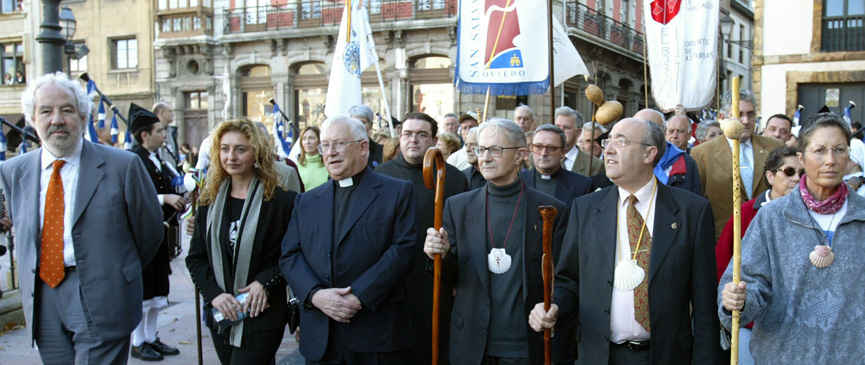The Princess of Asturias Foundation
Sección de idiomas
Fin de la sección de idiomas
Sección de utilidades
Fin de la sección de utilidades
- The Foundation
- HM The King
- HRH The Princess of Asturias
- 2023 Special
- Princess of Asturias Awards
- Area of Communication and Media
- Music Department
- Exemplary Town of Asturias Award
- 2012 Special
- 2013 Special
- 2014 Special
- 2015 Special
- 2016 Special
- 2017 Special
- 2018 Special
- 2019 Special
- 2020 Special
- 2021 Special
- 2022 Special
-
Important: COVID-19
-
Terms of Use
You are in:
Laureates
Start of main content
The Way of Saint James
Prince of Asturias Award for Concord 2004

According to tradition, the Way of Saint James began in the ninth century when the remains of Saint James the Apostle were discovered in Libredón Forest, where the city of Santiago de Compostela now stands, and where the saint's relics are kept in the Cathedral. From these beginnings the pilgrimage to Santiago became a driving force for extraordinary spiritual, social, cultural and economic vitality. In the course of its 1,200 years of history, it also became a symbol of fraternity amongst different peoples and the corner stone and focal point for an incipient, generalised awareness of Europe.
The Way of Saint James was spawned in and by a religious-minded society. Religious motivation lives on today, although meeting other people, personal achievement and integration with nature and art have also come to figure as reasons to undertake the pilgrimage, which has become a mass phenomenon of pilgrims and volunteers from the four corners of the globe. One example of its popularity is that calculations put the number of pilgrims that will have visited Santiago de Compostela by the end of the Holy Year, this 31st December, at a record six million. Improvement and maintenance of the 800 kilometre-long Road, which for the most part crosses Spain and France, is the work of thousands of volunteers and hospice wardens.
In 1987 the Council of Europe named the French Way as First European Cultural Itinerary. In 1993, UNESCO highlighted the importance and significance of the Way of Saint James by declaring it part of Mankind's Cultural Heritage. The Council of Europe confirmed its backing in 2004 by naming it a Primary European Cultural Itinerary, stating that it demonstrated "the importance of man in society and the ideas of freedom and justice [?] (it is) a niche for tolerance, learning and solidarity, for dialogue and coming together."
End of main content
Sección de utilidades
Fin de la sección de utilidades
- Legal document Legal document (Access key 8)
- | Privacy policy Privacy policy (Access key )
- | Social networks ???en.portal.pie.menu107.title???
- | Cookies ???en.portal.pie.menu110.title???
- | Site map Site Map (Access key 3)
- | Contact Contact (Access key )
- | XHTML 1.0
- | CSS 2.1
- | WAI 'AA
© Copyright 2024. FUNDACIÓN PRINCESA DE ASTURIAS



